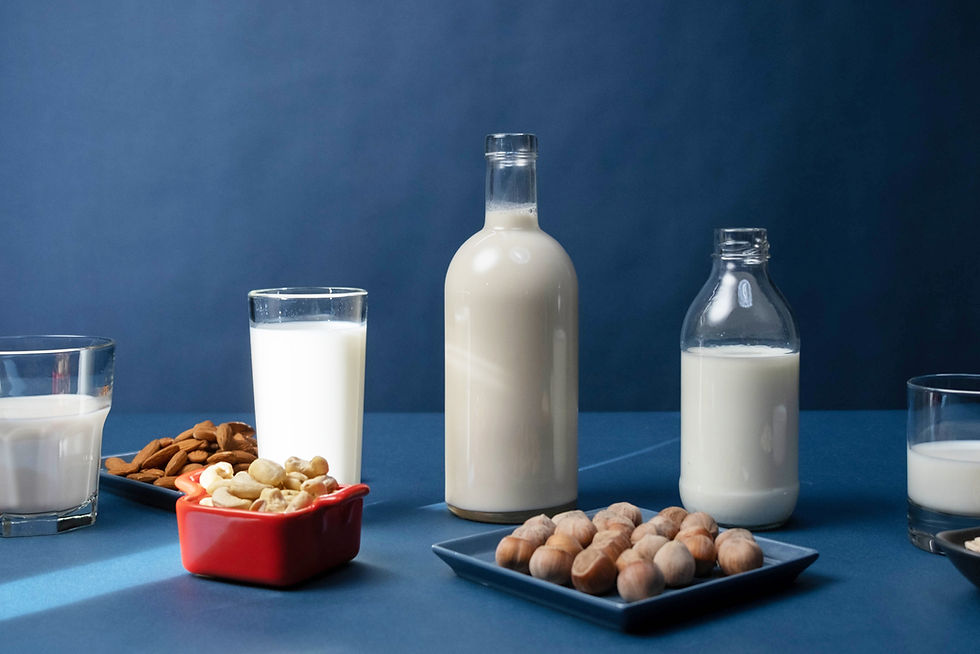Are Almonds Bad For The Environment?
- The Young Vegan

- Apr 2, 2023
- 3 min read
The vegan movement is being heard, more people are reducing the amount of meat that they eat, they are finding alternatives to animal products for food, clothes, shoes and more. This is making the hard core meat eaters angry and they're fighting back with arguments about the damage that vegans are doing by eating avocados, about forests being cleared to grow soya for tofu and almonds killing bees. This is why it's important to be armed with the facts when you enter discussion with people, even fellow vegans. So, almonds are killing bees? Let's take a look.

Almond Milk Instead of Dairy
Researchers at the University of Oxford showed that every glass of dairy milk causes the release of almost three times more greenhouse gas emissions than any plant-based milk, including almond milk, and uses nine times more land. This comes from breeding and raising cows, growing crops to feed the cows, the process of milking and pasteurising the milk and the methane that cows produce. Almond trees also take up land, but they use far less land than dairy cows with most of the world's crop of almonds is grown in California’s Central Valley, over an area the size of Delaware, these are then transported around the world. The same could not be achieved with dairy cows, it would impossible to produce the majority of the world's milk in an area the size of Delaware, however, almonds do have their downside.
Of all of the plant milks on offer, including soya, oat and rice, almond milk needs the most water. It takes roughly 130 pints of water to produce just one glass of almond milk, according to the Oxford study, then there is the use of bees to pollinate in the flowers. In the USA there is a large industry in beekeeping that involves taking bees from one farm to the next to pollinate crops. The bees are trapped within their hives for the journey, released to pollinate the flowers and then collected back up into their hives and transported, by truck, to the next field. Nearly 70% of the USA's commercial bees are brought in to pollinate almonds every year. This is incredibly stressful for the bees, they do not travel well, being moved to new areas and forced to eat a mono-crop, unable to find the variety of plants that they want, is hard on them. This results in many deaths, sometimes many whole hives will be wiped out in one go. Deaths can also result from bees feeding on the nectar of crops that have been treated with pesticides as the bees die from poisoning.

What's A Better Alternative?
There are many different plant milks to choose from, rice, coconut, soya, pea, hemp, peanut and more. But, the option that has the least drawbacks is oat milk. Oats are grown in cooler climates, such as in the UK, USA and Canada, growing oats does not involve deforestation and uses less water than almond milk. Oat milk is very versatile and can be bought in fortified forms, with added vitamins D, B12, iodine and calcium. But, at the end of the day, it comes down to preference, if you prefer almond milk, use almond milk, if not choose something else, as long as it's not dairy. The graph above shows that dairy milk has a wholly negative effect on the environment, but it also has a wholly negative effect on the cows, their calves, and on human health. All of the plant milks are more positive than cow milk, so try a few out and see what you prefer, there's a plant milk out there for everyone.




شيخ روحاني
رقم شيخ روحاني
الشيخ الروحاني
الشيخ الروحاني
شيخ روحاني سعودي
رقم شيخ روحاني
شيخ روحاني مضمون
Berlinintim
Berlin Intim
جلب الحبيب